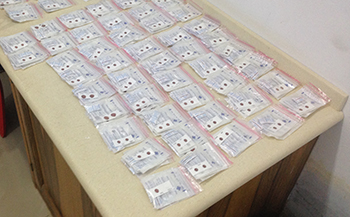
Despite recent declines in the number of cases worldwide, malaria remains a public health concern with 3.2 billion people still at risk of infection globally. [1] Fortunately, malaria is a treatable disease – artemisinin is an effective and potent drug recommended for treatment of uncomplicated malaria cases in most parts of the world. However, the success of this frontline drug is threatened by emerging resistance.
In Southeast Asia, patients are becoming less and less responsive to treatment as Plasmodium falciparum, the most deadly malaria parasite, becomes resistant to artemisinin and, in some areas, also to the partner drugs that are administered with it.
Clinicians and researchers now fear that resistance could spread from Southeast Asia to Africa, where the disease burden is much higher, possibly triggering a public health crisis. This fear is made concrete by the fact that this has occurred twice in the last 60 years alone.
Advances in genomics research and DNA sequencing technologies, have helped us to get a better understanding of how parasites evolve to become resistant to drugs. We can directly observe, in a fast and effective way, significant changes to their genome and evaluate whether this represents early signs of emerging resistance or just ‘physiological’ variations. [2] In this way, we can appropriately inform treatment strategies to minimise the potential for resistance to become epidemic, for example by switching drugs before it’s too late.
Looking at the parasite genome, we can also better understand the movement of malaria parasites between geographical regions and the routes through which they are spreading. This information is crucial for the planning of malaria intervention strategies.
The Malaria Genomic Epidemiology Network (MalariaGEN) pioneered the study of genome variation in malaria parasite populations through the P. falciparum Community Project, a large-scale collaboration that has sequenced the genomes of thousands of samples collected from over 20 malaria endemic countries, to study evolutionary processes such as drug resistance. Since this work began, new projects have been established to study other Plasmodium species (P. vivax Genome Variation Project) and, more broadly, to improve our methods for genomic studies of malaria parasites (Pf3k).
In addition to advancing our scientific knowledge, the holy grail for genomic epidemiology of malaria remains, in many ways, the ability to use this information to inform public health interventions – the focus of our latest parasite project, SpotMalaria.
SpotMalaria gets its name from the dried blood spots that are at the core of the project’s sampling strategy. Thanks to recent technical and analytic advances, we can routinely sequence parasite DNA from small blood spots collected on filter papers.
This field-friendly method allows us to expand the number of locations where we can sample, including resource-limited settings. We have created a pipeline allowing us to rapidly process these samples and return genetic data to policy makers before the start of the next high-transmission season. The aim is to help policy makers answer crucial questions, for example: Where do the parasites in their area originate? Do these parasites have molecular markers of antimalarial drug resistance, necessitating a change in drug treatment regimens? In this way, we can inform surveillance and treatment strategies to reduce the potential development and spread of resistant malaria infections across a variety of settings.
References
[1] World Health Organization. World Malaria Report 2015. Geneva, Switzerland, 2015.
[2] MalariaGEN Plasmodium falciparum Community Project. Genomic epidemiology of artemisinin resistant malaria. eLife 2016;5:e08714. DOI: 10.7554/eLife.08714.

